Lincoln Electric is one of the pioneers of welding in the US, but they continue to impress the welding world with their innovations. The Power Wave welding platform introduced some state-of-the-art machines with advanced processes that offer the highest quality welding results.
Our previous articles discussed welding machines, such as Lincoln Power Wave C300, S350, and S500, but in this one, we will thoroughly explain the technologies behind them.
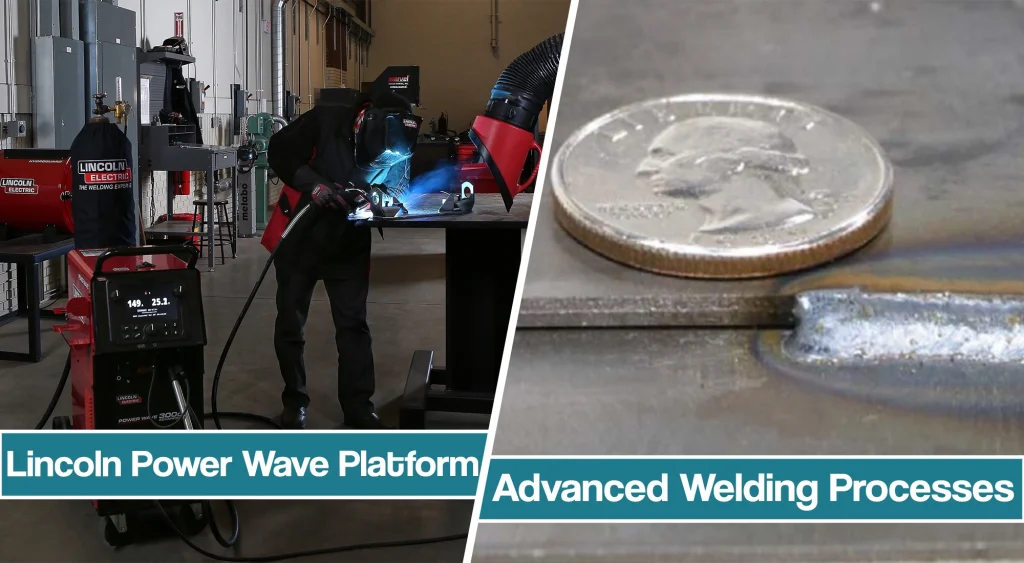
The advanced process welders result from Waveform Control Technology that supports eight processes, over 80 weld procedures, and the option to fine-tune or develop new welding programs.
About Lincoln Electric Power Wave Welding Platform
Lincoln’s Power Wave welding platform introduced something many welders asked for in the past – the ability to tailor your welder to perfectly suit your needs.
If you browse today’s welding market, various multi-process welders or industrial machines are dedicated to a single or two connected welding processes. The troubles start if your welding projects or tasks require multiple welding processes.
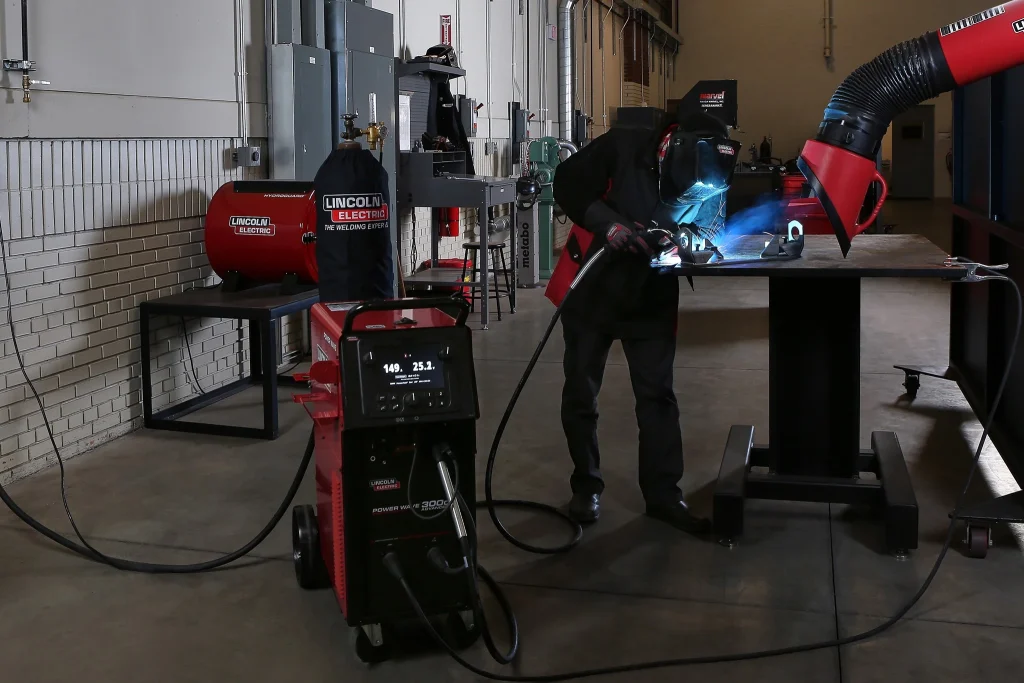
In that case, you are forced to buy several separate welding machines, and that’s usually not the cheapest solution.
Lincoln Power Wave welding platforms, such as S350 or S500, come as a fully modular power source. The basic package includes a Stick welder and a DC TIG welder, but it doesn’t end there. You can buy a module to introduce AC/DC TIG welding with a high-frequency start for aluminum or a wire feeder to get MIG welding capability. Simply put, the world is your oyster.
These are all the common welding processes you see at any other welder, but Lincoln didn’t stop there. There are specific modules that introduce advanced welding processes, and they are the courtesy of Lincoln Waveform Control Technology.
Waveform Control Technology
Lincoln describes the Waveform Control Technolgy as “revolutionizing the way welding equipment is chosen.” This technology allows welders to customize the waveform output, including eight processes and over 80 weld procedures.
Users can choose a welding program from a pre-defined set and manipulate the parameters of that program to best fit their application. The best part about it is allowing welders to use a single power supply to perform Stick, TIG, MIG/MAG, Flux-cored, and Submerged Arc welding procedures.
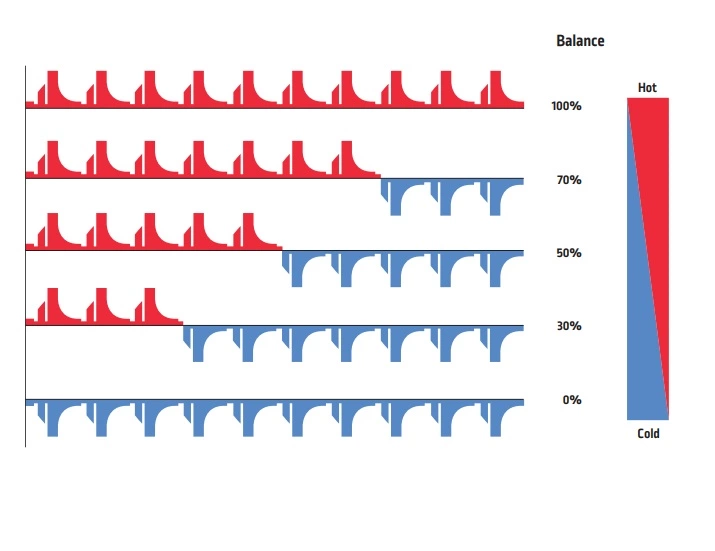
Besides the Power Wave advanced welders we mentioned, Waveform Control Technology can be found in Power MIG 300 and Invertec V350-PRO welding systems. They come fully loaded with a software library that is accessible from the user interface.
How Waveform Control Technology Works?
Waveform Control Technology recognizes the crucial factors that affect the welding arc and metal transfer: surface tension, magnetic, and aerodynamic forces. Welding current affects the magnetic and aerodynamic forces and changes the way the arc forms and penetrates the base metal. In addition, current and surface tension can affect the way and how much metal is transferred into a weld puddle.
High-speed electronics monitor the electrical signals from the welding arc to improve its characteristics. The appropriate changes to the current waveform, therefore, improve penetration and overall weld results and increase deposition rates while reducing the amount of welding fumes. The electronics are fast, accurate, and built to withstand harsh welding environment.
Advanced Welding Processes
In this section, we will discuss the specific advanced welding processes that Waveform Control Technology brings. These include HyperFill, RapidArc, Rapid X, Rapid Z, STT, Low Fume Pulse, Precision Pulse, and Pulse on Pulse.
Each shines in its own category, increasing the overall penetration, speed, and deposition rates while minimizing fumes, spatter and heat input.
Hyperfill Process
Hyperfill is an advanced welding process for MIG welder aimed at heavy production that increases the deposition rates by utilizing a twin MIG wire. The best part about it is that you only need a single power source, a single wire feeder, a single tip, and a Lincoln Electric premium wire.
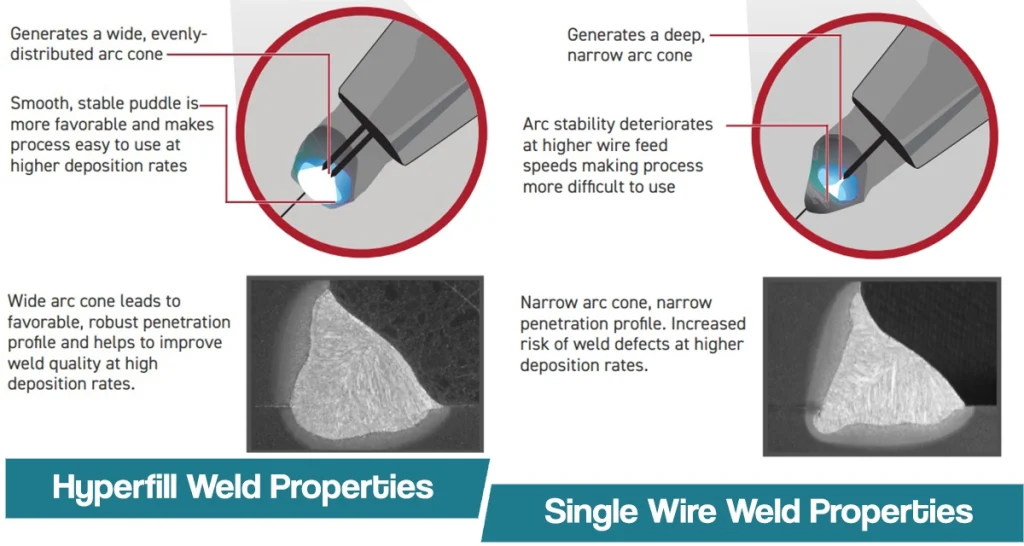
By introducing two MIG wires, you get a wider, smoother, and more stable welding arc, that penetrates metal evenly. Wide-arc cone results in a robust penetration profile and improves weld quality, but that’s not all. Two MIG wires provide deposition rates above 18lbs/hr for manual or 24 lbs/hr for automated welding.
Comparison-wise, a single MIG wire during the 3-minute 2F welding of a 5/16″ piece at 13 in/min travel speed produced 13 lb/hr deposition. Meanwhile, the Hyperfill process at the same parameters resulted in 16-20 lb/hr deposition with Power Wave R450 / S500 & Pipefab welders and 20-24 lb/hr with Power Wave S700 welders.
In addition, .035 HyperFill L-59 wire that is tailored for this process produced less than 0.2 gr/min fumes, which was among the lowest results in tests. This process can be used with Power Wave® S500, S700 PIPEFAB™ (Process Pipe) Cool Arc® 55 or 55S Cool Wave™ 20S power supplies.
RapidArc Weld Process
The RapidArc weld process is designed for robotic or automated, semi-automated and hard automation applications. The sole purpose is to increase the travel speed while reducing the spatter and heat input that results in distortion.
This is actually an advanced type of pulse that is highly suitable for thin material semi-automated and automated welding. The traditional pulse in automated applications utilizes a somewhat longer arc length to reduce the spatter, but it results in lower travel speed.
Lincoln’s experts recognized this problem and created the RapidArc process that keeps the arc length short and tight while controlling the spatter and metal transfer.
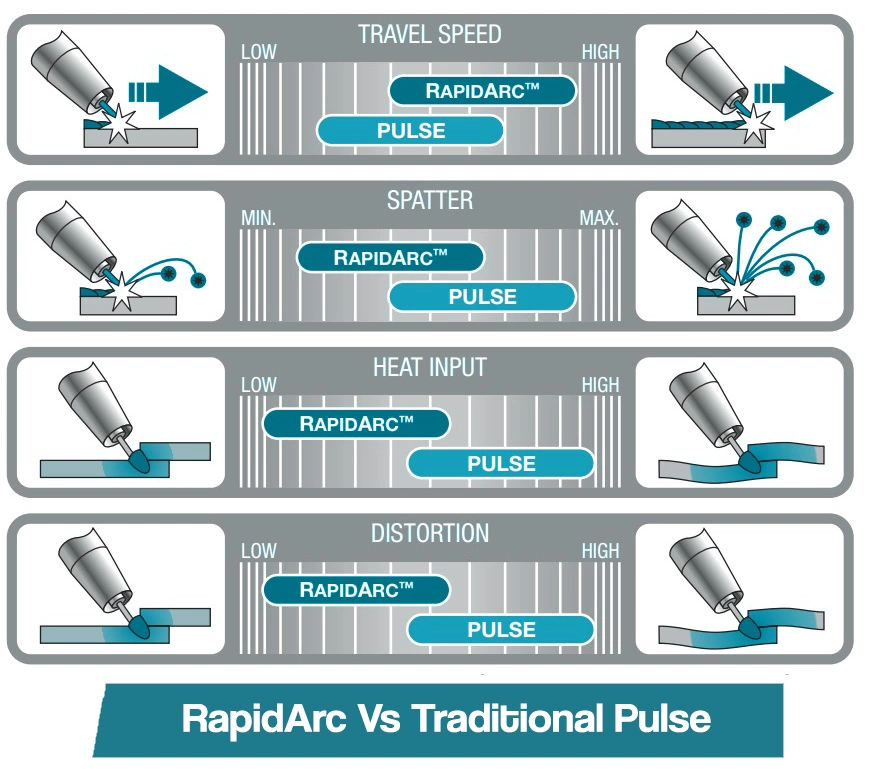
UltimArc completes the advanced controls for fine-tuning travel speed, spatter, puddle fluidity, and penetration As a result, you can achieve up to 50% higher travel speed and 15% less spatter with lower heat input and distortion compared to traditional pulse. RapidArc advanced process can be used with Power Wave C300, S350, R350, ® S500, R500, or S700 power sources.
Rapid X Weld Process
Rapid X is an advanced weld process based on Rapid Arc technology, and it also represents an advanced type of pulse. While the traditional pulse utilizes a peak and background current to deposit a molten droplet after each pulse, Rapid X combines a low-current wet-in technology that momentarily drops the current producing spatter-free welds.
As a result, the Rapid X process provides up to 40% faster travel speed, which is slightly lower than Rapid Arc, but up to 30% less spatter than traditional pulse and almost double that of Rapid Arc. Therefore, this is a crucial method for extreme productivity that requires exceptional, spatter-free welds.
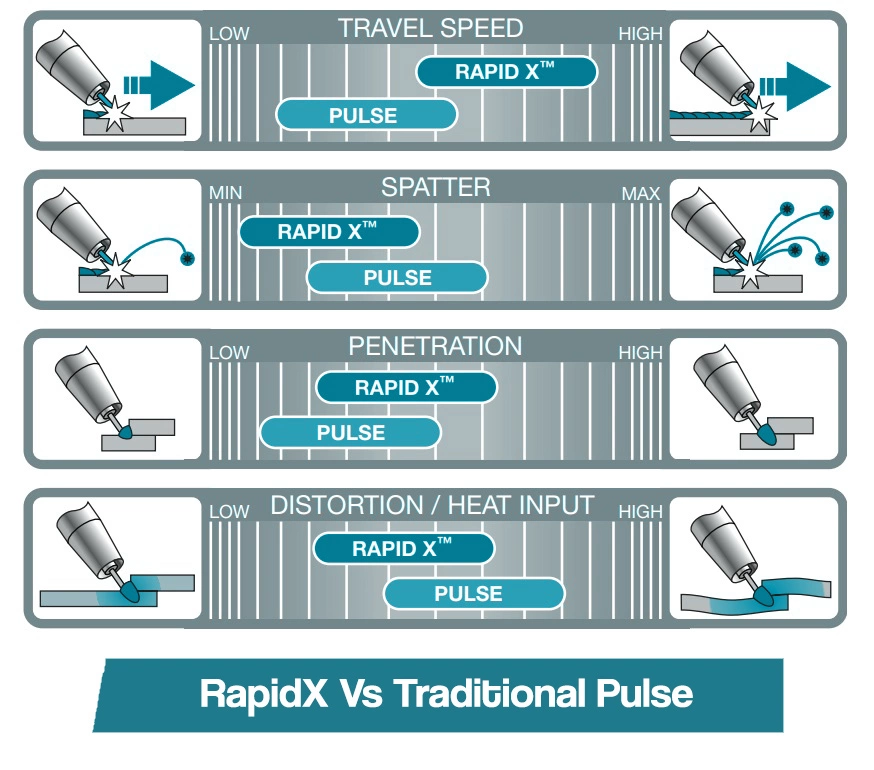
This advanced process is available with Power Wave S350, R350, S500, or R500 welders with Digital STT Module.
Rapid Z Process
Even though Rapid Z sounds like Rapid X or Rapid Arc processes, this one is specifically designed for welding galvanized steel.
Welding on galvanized can be challenging since the zinc coating thickness, and part fit-up varies. That commonly results in porosity, so the welders have to compromise between proper weld size, faster weld speed, or good x-ray quality.
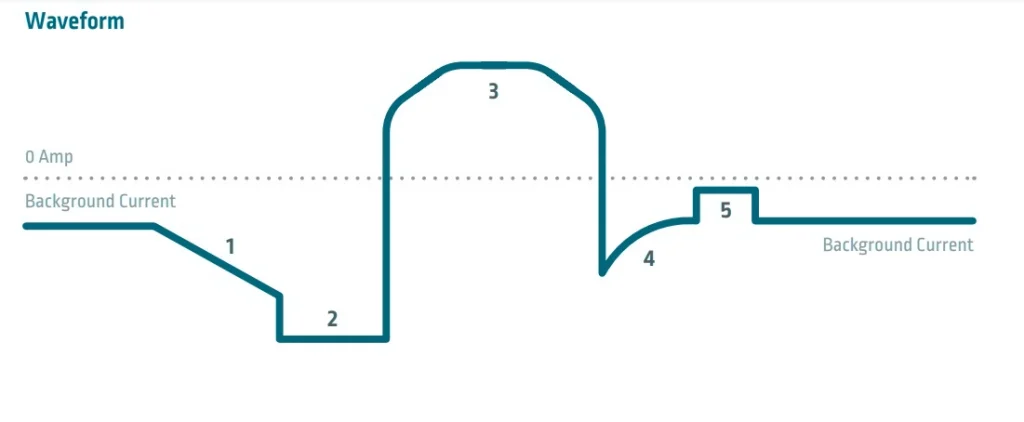
Rapid Z Waveform technology with Metalshield Z gas-shielded wire minimizes the internal porosity of welds and assures there is no external porosity. In addition, like Rapid Arc, it provides faster travel speed. Fine-tune options ensure that droplet transfer is focused and predictable. As a result, less of the surrounding zinc coating is introduced into the weld, meaning a lower risk of porosity.
Surface Tension Transfer – STT Weld Process
STT, or Surface Tension Transfer, is an advanced transfer mode for a MIG welder that represents modified short circuit transfer. The Waveform Control Technology allows operators to balance the waveform’s ratio of DC+ or DC- polarity perfectly. As a result, you get a customized penetration profile that is suitable for a broad range of material thicknesses.
That’s why there are several variations of this mode designed for open root pass pipeline welding, AC welding, and brazing.
STT Root Pass
STT Root pass process is designed for open root welding. This unique process requires less operator experience while still providing a larger bead, flat face, perfect back bead, and excellent fusion.
In Lincoln’s tests on 18″ Pipe Joints per 8-hour day, the STT Root Pass method was 2 times faster than SMAW and 4 times faster than GTAW.
Compared to typical short circuit transfer, STT doesn’t cause common issues such as burn-through and lack of fusion.
STT Pipeline process is available with Power Wave S350, R350, S500, or R500 welding machines, with Digital STT Module or Advanced Module.
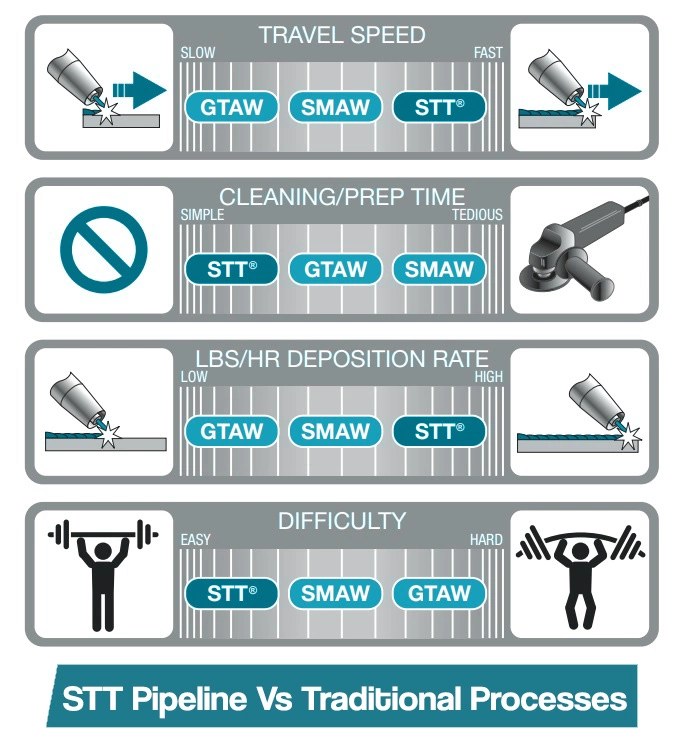
AC STT Process
AC STT process is specifically designed for AC MIG welding on extremely thin materials. Compared to traditional short-circuit transfer and AC current welding, the arc is extremely consistent, and you can perfectly adjust the heat and penetration.
The STT with AC welding allows precise heat-input control, which is crucial with materials down to 0.02 in (0.6 mm) thin.
The risk of distortion or burn-through is minimal, and you don’t even need to use a backing bar heatsink. This process is available with Power Wave S500 Power Wave R450 welders with an AC-STT Power Wave Advance Module.
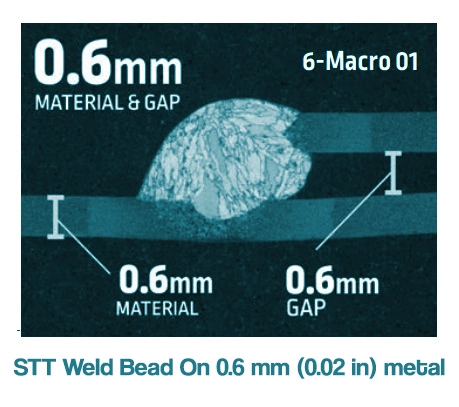
STT Brazing
STT Brazing process is designed to improve productivity and quality in robotic brazing.
Advanced technologies provide improved arc performance for fast, low-spatter brazing with exceptional bead appearance. Lincoln advertised this process as the most straightforward, cost-effective brazing solution on the market.
This advanced process reduces the risks of common wire-feeding and system complexities in robotic brazing.
As a result, operators can focus more on production and and less on system maintenance.
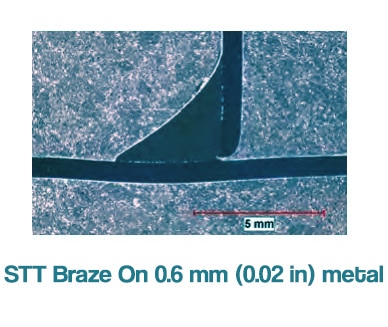
Low Fume Pulse Process
Low Fume Pulse process utilizes Waveform Control Technology for advanced arc performance that minimizes heat input and reduces weld fume generation directly at the arc. As a result, this advanced process simultaneously improves operator productivity and safety. Compared to the traditional Constant Voltage (CV) MIG, Low Fume Pulse produces up to 66% fewer fumes with 0.052 wire at 400 WFS speed.
This process is an excellent first step in welding fume control at the workplace. By reducing the fumes at the very arc, the requirements for the local exhaust system, respiratory protection, and general ventilation are lower.
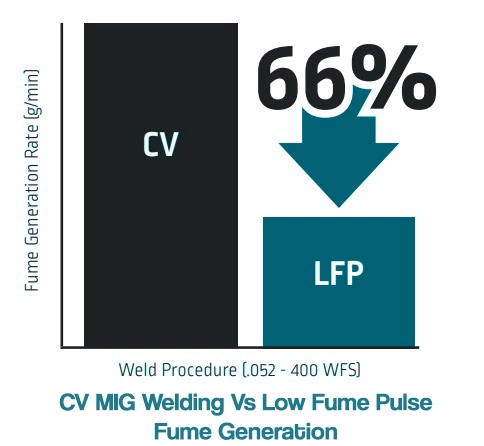
You can find Low Fume Pulse process at Power Wave S500, R500, or R450 with STT Module or Advance Module.
Precision Pulse Weld Process
Precision Pulse advanced welding process enhances puddle control to produce extremely focused arc at a lower voltage. A shorter, more focused arc increases puddle control which is crucial for out-of-position welding.
A focused arc provides controlled heat input and improves welds in tight joints. While the travel speed and puddle fluidity are lower compared to traditional pulse, out-of-position welding in tight joints is extraordinary.
This advanced process is found with Power Wave S350, R350, S500, or R500 welders.
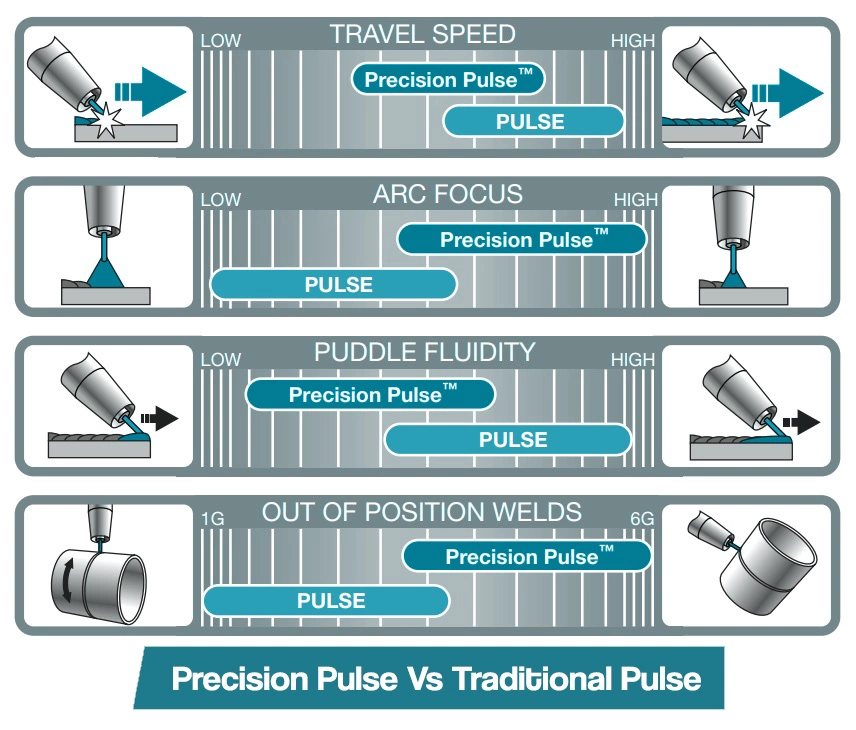
Pulse on Pulse Process
Pulse on pulse is a Lincoln patented process particularly designed for relatively thin (less than 1/4” thick) aluminum. On the market, this technology can also be found as a double pulse, but Lincoln made it pretty advanced. Compared to traditional pulsed MIG, the Pulse on Pulse process utilizes two distinct pulse types.
High-energy pulses provide spray transfer to quickly transfer metal across the arc. Depending on the wire feed, a series of an identical number of low-energy pulses are performed afterward.
As a result, this process excellently controls the heat, which is crucial when trying to avoid distortion, wrapping, and burn-through with thin aluminum welding.
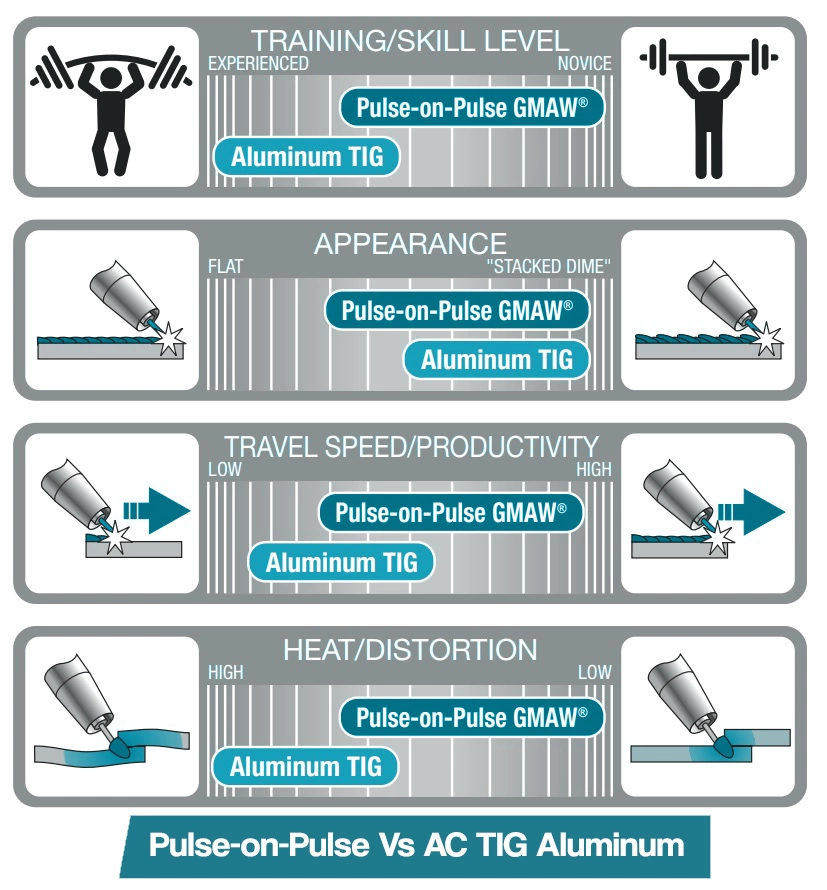
It also makes aluminum welding more straightforward compared to traditional TIG welding. The best part about it is that with enough practice, you can even get a TIG-like weld appearance aesthetically wise.
Pulse on pulse process is available with POWER MIG 350 MP, Power Wave C300, S350, i400 & S500 INVERTEC V350-PRO welders.
Process Control Technology
Besides including advanced processes for specific welding applications and best results, Lincoln works exceptionally on process control and production manufacturing.
The latest Power Wave machines are fully compatible with the Industry 4.0 module, which includes a series of free software that allows owners to control welding processes for the best, repeatable welds, and manufacture welding production in order to reduce possible costs and get the best out of each weld.
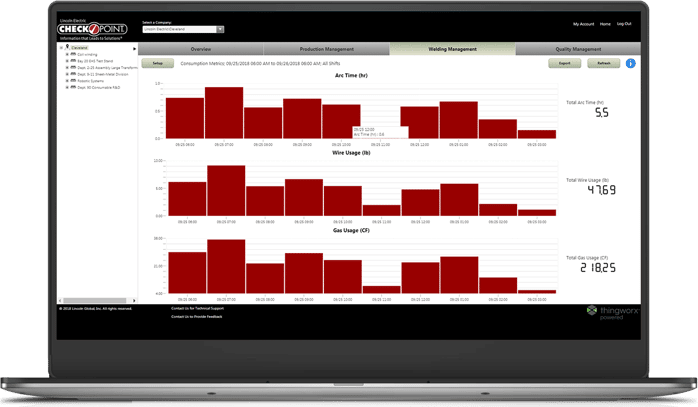
Process Control Solutions
Lincoln offers state-of-the-art process control solutions that come as Power Wave manager for the machines from the Power Wave line, as well as Weld Sequencer software. Power Wave manager allows operators to focus more on welding rather than setting the machine.
You can easily configure and select procedure memories or save them on a USB stick and transfer them to all welders that are doing the same task. As a result, you get repeatable results and standardize your fleet’s welding procedures.
Weld Sequencer software delivers intelligent, visually-aided process control. With it, you can automatically track weld count, cycle time, and deposition. Continuous on-screen weld metrics & verification help welders have perfect control of the entire welding process.
Production Monitoring
Lincoln’s Check Point framework provides full visibility of welding operations. It shows essential welding data such as operator arc on time, OEE metrics, material consumption, or weld and assembly information.
Each one of these is crucial when calculating overall welding costs. Manufacturers are often unaware of how can a single metric cut down the overall welding costs meaningfully, and easier production monitoring was the original idea behind the Check Point system.
Therefore, CheckPoint Production Monitoring allows key stakeholders to view and track welding data anywhere in the world on any device.





